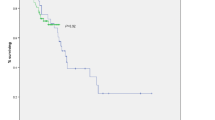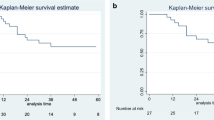Abstract
Background
Pseudomyxoma peritonei (PMP) is a rare, slowly progressive disease whose prognosis depends primarily on the completeness of cytoreduction. The value of intraoperative hyperthermic intraperitoneal chemotherapy (HIPEC) and of additional factors predicting long-term outcome and disease-free survival (DFS) remains poorly understood. This study aims to analyse survival rates and prognostic factors in patients undergoing maximal cytoreduction and HIPEC.
Methods
Thirty patients were selected from a prospective database of records for patients undergoing cytoreduction and HIPEC with mitomycin C or paclitaxel. Overall survival (OS), DFS, and the prognostic factors influencing them, were examined using multivariate analysis.
Results
Median follow-up was 44 months (range, 8–144). Histological classification of PMPs was DPAM in 6/30 of cases, PMCA-I in 10/30 and PMCA in 14/30. Complete cytoreduction (CC-0 and CC-1) was achieved in 28/30 of patients and CC-2 in 2/30. Median OS was 111 months (range 0–230) and five-year OS rate was 67%. Median DFS was 53.5 months (range 0–120) and 5-year DFS rate was 44%. Incomplete cytoreduction, lymph node involvement and PCI>20 were associated with poor prognosis for OS, while lymph node involvement, elevated CA-125 levels, unfavourable histology and previous chemotherapy were associated with poor outcomes for DFS. There was morbidity of Grade 3 or higher in 9/30. Post-operative mortality occurred in 1 case.
Conclusion
Cytoreduction plus peritonectomy procedures combined with HIPEC is a safe treatment and could improve survival rates. Since the optimal cytoreduction is the primary prognostic factor, patients should be centralised under the care of experienced teams.
Similar content being viewed by others
References
Smeenk RM, Verwaal VJ, Antonini N, Zoetmulder FAN (2007) Survival analysis of pseudomyxoma peritonei patients treated by cytoreductive surgery and hyperthermic intraperitoneal chemotherapy. Ann Surg 245:104–109
Baratti D, Kusamura S, Nonaka D et al (2009) Pseudomyxoma peritonei. Ann Surg 249:243–249
Cascales Campos P, Muñoz Casares C, Rufían Peña S et al (2009) Ovarian peritoneal mucinous carcinomatosis and pseudomyxoma peritonei of ovarian origin. Are they the same? Cir Esp 85:55–57
Sugarbaker PH (1994) Pseudomyxoma peritonei: a cancer whose biology is characterized by redistribution phenomenon. Ann Surg 219:109–111
Esquivel J, Sugarbaker PH (2001) Pseudomyxoma peritonei in a hernia sac: analysis of 20 patients in whom mucoid fluid was found during a hernia repair. Eur J Surg Oncol 27:54–58
Ronnett BM, Kurman RJ, Zahn CM et al (1995) Pseudomyxoma peritonei in women: a clinicopathologic analysis of 30 cases with emphasis on site of origin, prognosis and relationship to ovarian mucinous tumors of low malignant potential. Hum Pathol 26:509–524
Sugarbaker PH, Ronnet BM, Archer A et al (1996) Pseudomyxoma peritonei syndrome. Adv Surg 30:233–280
Sugarbaker PH (1995) Peritonectomy procedure. Ann Surg 221:29–42
Gonzalez-Moreno S, Sugarbaker PH (2004) Right hemicolectomy does not confer a survival advantage in patients with mucinous carcinoma of the appendix and peritoneal seeding. Br J Surg 91:304–311
Chua TC, Yan TD, Smigielski ME et al (2009) Long-term survival in patients with pseudomyxoma peritonei treated with cytoreductive surgery and perioperative intraperitoneal chemotherapy: 10 years of experience from a single institution. Ann Surg Oncol 16:1903–1911
Elias D, Honoré C, Ciuchendea R et al (2008) Peritoneal pseudomyxoma: results of a systematic policy of complete cytoreductive surgery and hyperthermic intraperitoneal chemotherapy. Br J Surg 95:1164–1171
Moran BJ, Mukherjee A, Sexton R (2006) Operability and early outcome in 100 consecutive laparotomies for peritoneal malignancy. Br J Surg 93:100–104
Cioppa T, Vaira M, Bing C et al (2008) Cytoreduction and hyperthermic intraperitoneal chemotherapy in the treatment of peritoneal carcinomatosis from pseudomyxoma peritonei. World J Gastroenterol 14:6817–6823
Yan TD, Links M, Xu ZY et al (2006) Cytoreductive surgery and perioperative intraperitoneal chemotherapy for pseudomyxoma peritonei from appendiceal mucinous neoplasms. Br J Surg 93:1270–1276
Güner Z, Schmidt U, Dahlke MH et al (2005) Cytoreductive surgery and intraperitoneal chemotherapy for pseudomyxoma peritonei. Int J Colorectal Dis 20:155–160
Loungnarath R, Causeret S, Bossard N et al (2005) Cytoreductive surgery with intraperitoneal chemohyperthermia for the treatment of pseudomyxoma peritonei: a prospective study. Dis Colon Rectum 48:1372–1379
Stewart JH, Shen P, Russell GB et al (2006) Appendiceal neoplasms with peritoneal dissemination: outcomes after cytoreductive surgery and intraperitoneal hyperthermic chemotherapy. Ann Oncol Surg 13:624
Elias D, Gilly F, Quenet F et al (2010) Pseudomyxoma peritonei: a French multicentric study of 301 patients treated with cytoreductive surgery and intraperitoneal chemotherapy. Eur J Surg Oncol 36:456
Ronnett BM, Zahn CM, Kurman RJ et al (1995) Disseminated peritoneal adenomucinosis and peritoneal mucinous carcinomatosis: a clinicopathologic analysis of 109 cases with emphasis on distinguishing pathologic features, site of origin, prognosis and relationship to ‘pseudomyxoma peritonei’. Am J Surg Pathol 19:1390–1408
Jacquet P, Sugarbaker PH (1996) Current methodologies for clinical assessment of patients with peritoneal carcinomatosis. J Exp Clin Cancer Res 15:49–58
Muñoz-Casares FC, Rufián S, Rubio MJ et al (2007) Treatment of peritoneal carcinomatosis from ovarian cancer. Present, future directions and proposals. Clin Transl Oncol 9:652–662
Younan R, Kusamura S, Baratti D et al (2008) Morbidity, toxicity, and mortality classification systems in the local regional treatment of peritoneal surface malignancy. J Surg Oncol 98:253
Gough DB, Donohue JH, Schutt AJ et al (1994) Pseudomyxoma peritonei. Long-term patient survival with an aggressive regional approach. Ann Surg 219:112–119
Miner TJ, Shia J, Jaques DP et al (2005) Longterm survival following treatment of pseudomyxoma peritonei: an analysis of surgical therapy. Ann Surg 241:300–308
Yan TD, Black D, Savady R, Sugarbaker PH (2006) A systematic review on the efficacy of cytoreductive surgery and perioperative intraperitoneal chemotherapy for pseudomyxoma peritonei. Ann Surg Oncol 14:484
Sugarbaker PH, Chang D (1999) Results of treatment of 385 patients with peritoneal surface spread of appendiceal malignancy. Ann Surg Oncol 6:727–731
Moran B, Baratti D, Yan TD et al (2008) Consensus statement on the loco-regional treatment of appendiceal mucinous neoplasms with peritoneal dissemination (pseudomyxoma peritonei). J Surg Oncol 98:277–282
Carmignani CP, Hampton R, Sugarbaker CE et al (2004) Utility of CEA and CA 19.9 tumors makers in diagnosis and prognostic assessment of mucinous epithelial cancers of the appendix. J Surg Oncol 87:162–166
Van de Vaart PJ, van der Vange N, Zoetmulder FA et al (1998) Intraperitoneal cisplatin with regional hyperthermia in advanced ovarian cancer: pharmacokinetics and cisplatin-DNA adducts formation in patients. Eur J Cancer 34:148–154
Author information
Authors and Affiliations
Corresponding author
Rights and permissions
About this article
Cite this article
Arjona-Sánchez, Á., Muñoz-Casares, F.C., Rufián-Peña, S. et al. Pseudomyxoma peritonei treated by cytoreductive surgery and hyperthermic intraperitoneal chemotherapy: results from a single centre. Clin Transl Oncol 13, 261–267 (2011). https://doi.org/10.1007/s12094-011-0651-8
Received:
Accepted:
Published:
Issue Date:
DOI: https://doi.org/10.1007/s12094-011-0651-8




